|
Paradise Found
- Pokhara, Nepal
"N-E-P-A-L ... Viva
Nepal!"
- Eddie Murphy, The Golden Child

Greetings from
Nepal,
we have landed in
a paradise and will wax poetical. Pokhara, the second largest town in Nepal (with a
population of 70,000) is nestled in the foothills of
the Annapurna massif of the Himalayas. Nepal shares
the
lofty heights of the Himalayas with Tibet to the
north,
and the flat plains of the Terai with India to the
South. It is a tiny nation with a population of only
22 million, and it is desperately poor. 95% of the population live rurally, while
75% is illiterate. Most people survive on subsistence farming, basically
growing just enough to eat. Aside from a few wealthy
individuals living in the urban centers and catering
to the tourism industry, most live very isolated
lives
in the hills and valleys, and little
of the outside world. Tourism is definately changing the face of that, at least on the current beaten
paths.
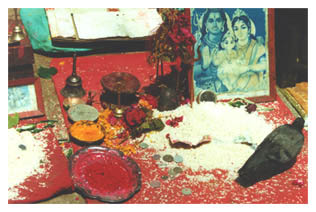
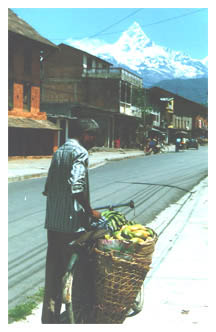 fruit
seller on Simalchaur road in New Bazaar, Pokhara fruit
seller on Simalchaur road in New Bazaar, Pokhara
Pokhara, seems to be just that sort of place. A city
carved from tourism and set 'plunk' into the most amazing
location. From our hotel window, you can glance
across
the placid waters of Lake Phewa and the surrounding
green foothills to the picture-perfect peak of
Machapuchre, aka Fishtail, a mountain,
to rival the Matterhorn. The
main tourist drag is lined with
endless restaurants, bars, and travel agencies
touting
mountain treks, white-water rafting, and jungle
safaris. And the food ...
Arriving in Nepal, we were extremely protein
deficient,
and longed for the taste of real beef. The first
night
out, we perused the menu and came across buff steak.
Was this another language miscommunication? Turns
out,
the locals, devout Hindus that they are, offer this
delightful substitute. Water buffalo, casually
abbreviated to Buff is everywhere, but, in steak form, it turns out
to be a chewy, stringy imitation. The ubiquitous
buffsteak, buff fry, buffburger, buff burrito, and
buff on a stick. Better off waiting for the real
deal,
which we found at the Everest Steak House.
They import it, they cook it, they serve it, but they
donít eat it. Beef, the holy grail of the
Indian subcontinent, and they have it in spades in
Nepal, for the right price. Our search for the meaty
elexir landed us at the Infamous Everest Steak house,
a joint solely devoted to serving massive quantities
of the practically illegal substance at comparitively
rock-bottom prices and it was GOOD! The best $3 steak
we have ever had, and this was no diner steak and
eggs.
It was a full-bodied, cooked to order, hunk of meat.
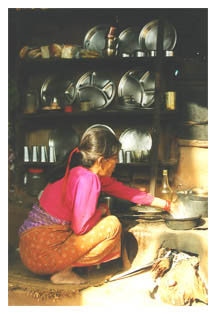
But
aside from T and Doug's insatiable appetite for meat, we all came to love
dudh chiya, Nepali's version of chai, a silky sweet, ginger-tinged, milky
steaming cup of tea. Made on every street
corner for a mere 5 rupees, start your day off right. Step up to any women
working in front of a fire-stoked clay stove and ask 'euta dudh chiya
dinus' and if she replies 'chinni?' you must answer 'chinni rhaaknus'
Better yet, grab some biscuits to dip. Nepalis have a fascination with
biscuits in all forms, sweet, salty, chocolaty, creamed and whatnot. But
the alltime best has got to be the aptly named 'glucose.' It's 12 rupees
of delight, and slightly reminiscent of vanilla wafers.
Viva Nepal!
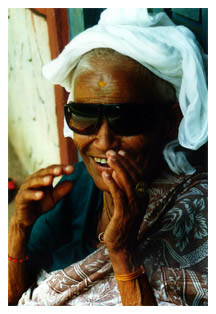 Say
Nameste to Haji, my Nepali Hajuraama, 'grandmother' Say
Nameste to Haji, my Nepali Hajuraama, 'grandmother'
No
doubt, much of our joy and love of Nepal sprung from our violent
reaction to Varanasi and the trip over. Nepal, in contrast to the harsh
reality of India, seems so much more at peace. While as painfully poor
as India, the people are more family oriented. There are no homeless
people sleeping in the gutters, atop their rickshaws. While there are
always touts, there seem to be more genuine people wanting to help, even
if they don't know the answer. (Beware of getting directions) And people
are quick to laugh and express joy here. There is something special about
Nepal...Viva Nepal!
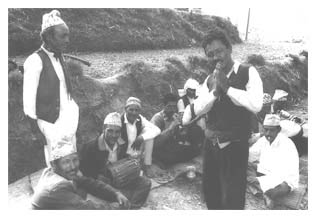
Nameste
- the traditional Nepali greeting loosely translates to 'I bless the
divine in you' Namaskar if you want to show extra special respect.
One of our main objectives in Nepal was to trek.
While
out talking to the different trekking agencies, we
noticed all the rafting trips available. Seems that
Nepal is also a hotbed of white-water rafting, with
the numerous rivers that flow out of the Himalayas.
We
chose a three-day trip down the sacred Kali Gandaki
River, which means death to foreigners. Joke...Actually, it was closer to the
truth, as the river is
classified as a class 4+. The plus is all the more
important because it indicates a level of difficulty
that is very significant post-monsoon when the rivers
are really pumping. I think we were in over our
heads,
as all three of us have never rafted before. The
first
day by the side of the river, we got our first safety
and paddling demo. It lasted all of twenty minutes.
The river looked extremely menacing and flowing very
fast. Our first challenge occurred almost immediately.
Two of the hardest rapids, one right after another,
occurred within the first fifteen minutes. As we
pushed
off, we wondered what we had got ourselves into. But
then we immediately paddled to the other shore and
stopped. Our group was big. Twenty one people plus
eight staff. We were comprised of three rafts, one
supply raft, and three safety kayakers, VERY
IMPORTANT!
We were all wondering why we stopped when we heard
from the other boat that two girls had begun to cry
and
wanted to be let out. They walked home.
And we went on. Going into the first rapid, it was
critical that we not flip. Well, that's always
critical
but this time more so, because if we did, we would
all
be washed into the following rapid which is
potentially
very dangerous. And we made it. I think we were all
so
excited that maybe we lost our head going into the
next rapid, because we hit a big wave, and the guy in
front of me just disappeared. But those safety
kayakers
were great. Our guide signaled and they just swooped
in and saved him. After talking to him, I decided
that I didn't want to ever get separated from the
raft, because going downstream in a raging river is
not fun. After a good afternoon of rafting, we camped
on a sandy beach and slept under the stars. The next
day was a full day of rafting and uneventful except
for T almost drowning. It was on a rapid named Evil
Refund, quite apt. We hit the rapid sideways, very
bad and due to our incompetent paddling, and then we were all
desperately clinging to hang on.
When we next surfaced, one side of the boat was gone.
Doug and I were still hanging on, but then we
realized
that T was nowhere to be seen. Our guide was
screaming
at us to paddle lest we lose everyone else, and we
did, all the while looking for our friends bobbing
heads. Of course, the safety kayakers got them all,
but
not before T described a harrowing ride underwater
in which he thought he was actually drowning. The
onslaught of continual rapids only allows you to
surface just enough to gulp another breath of air before forcing you back under for what seems an
eternity. But we were all safe and sound in the end
and T lost only a toenail. OUCH
We would highly recommend white-water rafting in
Nepal
and it is unbelievably inexpensive. In general, trips
cost about $25 a day for all equipment and food
and camping gear. Excellent fun!
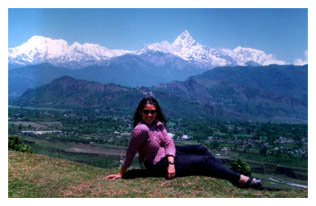
Once back in Pokhara, we set out to set up our trek.
Pokhara is the main jumping off point for the
highly popular treks into the Annapurna region of the
Himalayas. Trekking (fancy term for hiking) basically
takes you to places where no roads have ever gone.
For
aeons, people have lived in these beautiful, isolated
foothills and mountains, and as such, have beat well-
trodden paths. Much of the appeal of trekking lies in
walking these same paths and meeting the extremely
friendly locals along the way and, for a moment,
slowing down to their pace of life and of course,
getting up close and personal with the highest
mountains in the world.
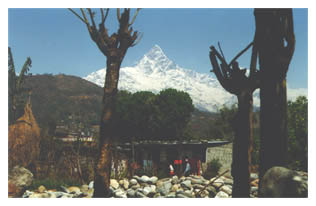
While
many will come for the mountains, most will return for the people. This
must be the start of a love affair with an entire country. Viva Nepal!
Next time, Doug and Ann's complete guide to trekking!
Ten four good buddies
index | back
| next |
